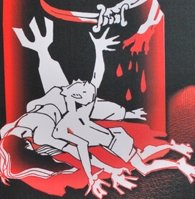 The issue most debated by intelligent Tamils last May, the 2nd Anniversary of Mullivaaikkaal, was the following: why did the leadership of Liberation Tigers of Tamil Eelam (LTTE), possessing more than three decades of military experience and expertise, stay in their last and shrinking base in Mullaiteevu until it was too late to escape into the Vanni jungle? On the 1st Anniversary we analysed the dimensions of the global war against the LTTE in the essay ‘The Tiger Safari’, of how more than 30 countries set the Organisation up for the kill, and all that the Sinhalese military did, in a manner of speaking, was pull the trigger. But the question is: why did the LTTE defend Mullivaaikkaal to the fatal end?
The issue most debated by intelligent Tamils last May, the 2nd Anniversary of Mullivaaikkaal, was the following: why did the leadership of Liberation Tigers of Tamil Eelam (LTTE), possessing more than three decades of military experience and expertise, stay in their last and shrinking base in Mullaiteevu until it was too late to escape into the Vanni jungle? On the 1st Anniversary we analysed the dimensions of the global war against the LTTE in the essay ‘The Tiger Safari’, of how more than 30 countries set the Organisation up for the kill, and all that the Sinhalese military did, in a manner of speaking, was pull the trigger. But the question is: why did the LTTE defend Mullivaaikkaal to the fatal end?
On foreign Santa Clauses
In the context of west’s military backing for the Colombo regime and the unfolding LTTE-led Tamil National Resistance, it is important to bear in mind the coordinates of western realpolitik encapsulated in Otto von Bismarck’s dictum: ‘The great questions of the day will not be decided by speeches and resolutions of majorities,’ [and, may we add, by conflict resolution] ‘but by blood and iron.’ The Americans, Europeans, including Norwegians, and Japanese have NOT come from thousands of miles away to altruistically assist the Tamil people secure their rights in Sri Lanka. They did and still do pretend to be a bunch of political Santa Clauses thirsting to help emancipate Tamils by promoting devolution out of sheer goodness of heart. They are entitled to their devious acrobatics. However, any Tamil, local or diaspora, who swallows that drivel is living in cloud cuckoo land!
Huts in Safe Zone
When their motives are doubted, the west’s cabal will also truthfully claim their objective is ‘peace and stability’ in Sri Lanka. But what they have in mind is the ‘peace and stability’ that do not obstruct the pursuit of their own geo-strategic rapacious interests. As Noam Chomsky acidly noted while commenting on west’s interventions in the Arab world, ‘instability is when anyone gets in the way.’ In Sri Lanka, the LTTE and Tamil nationalism got in the way. Therefore ‘peace and stability’ means stabilising the Sinhalese regime by crushing LTTE’s military challenge – that was done – and bringing Tamil nationalism to heel, which process is ongoing both in Sri Lanka and among the Tamil diaspora.
There are Eelam Pundits – Sivaram’s apt, perhaps sarcastic, expression – who deluded themselves; they had asserted, ‘yes, we know the international community has its agenda but so do we and we can use them’ or words to that effect. As is apparent from the LTTE’s defeat, the dog (IC) can wag the tail (Eelam Pundits) but the tail cannot wag the dog!
The snare called Mullivaaikkaal
One part of the answer to the above question could be found in D. Sivaram’s (‘Taraki’) analysis of ‘pacification’ measures (he applied the appropriate term ‘pacification’ instead of ‘counter-insurgency’) by western powers, India and Sri Lanka, coordinated by Norway. Before his murder in 2005, he elaborated on his ideas to Mark P. Whitaker; and Sivaram explained: ‘The main aim of pacification in modern counter-insurgency techniques is the closure of the political space from which a rebellion derives its staying power and vitality to spread its influence with ease. The military drive against a rebellion can consolidate its successes ultimately only if it can achieve a near total closure of the political space in which a rebellion is brought forth and thrives.’
The LTTE created and kept open the ‘political space’ by carving out liberated regions it controlled, administered and raised revenue from in primarily the Vanni and in several parts of the north and east.
Added Whitaker: ‘And it was with this strategic end in view, Sivaram argued, that most of the LTTE’s tactics – its suicide bombings, its efforts to establish a conventional army and its creation of a Jaffna proto-state – could best be understood. That is, as disparate parts of a well thought out, historically unique, if ruthless, “counter-pacification strategy” primarily designed around the need to keep precisely such a rebellious political space open.’
In other words, the LTTE leadership neutralised the pacification strategies crafted by much-vaunted counter-insurgency ‘specialists’ perched in mostly western strategic studies institutes. Crucially, the Organisation’s counter-pacification largely insulated the Tamil populations from the political machinations of States – predominantly US, UK and EU, Norway, China, India and Sri Lanka – hostile to the Tamil Nationalist Resistance. The crumbling counter-insurgency architecture no doubt set off alarm sirens in the capitals ranged against the LTTE.
The LTTE’s resolute defence of its shrinking base in the Vanni was a logical if desperate counter-pacification, including repression, to protect and retain control of the liberated area – the ‘political space’ – and its corresponding population, however small, in order to sustain the Resistance. Washington (and its poodle, Oslo), London, Brussels, Beijing and New Delhi evidently grasped LTTE’s strategy for they dredged up cunning apprehensions for ‘Tamil civilians’ to mask their implacable opposition to and crafty manoeuvres against LTTE’s counter-pacification.
The other part of the answer to the question must, in retrospect, be teased out of the basic realities that informed and directed the Machiavellian actions of hostile States.
(a) A ceasefire was the sole instrument available to the LTTE to keep open the ‘political space’ in the context of the overwhelming military imbalance in favour of the Sri Lankan regime (backed by more than thirty countries including the most powerful nations).
(b) If the Organisation’s leadership found a ceasefire is not on the cards, they would promptly abandon the ‘political space’ in Mullaiteevu and melt into the jungle.
(c) But if the leadership could be inveigled into believing a ceasefire is likely, the LTTE would stay back and defend the base in Mullaiteevu (and later within its eastern sliver, Mullivaaikkal) long enough for the Sinhalese military to encircle on land and cut off escape routes by sea.
So, the western powers, working through Norway, and in collusion with India set entrapment into motion; they dangled the bait – the ceasefire and the implied reprieve – and lured the LTTE leadership into clinging to their last bastion until it was too late to break out.
The ‘ceasefire’ drama
There are several strands to pacification during the closing stages.
(a) States hostile to the Tamil Nationalist Resistance supplied banned weapons (chemical and cluster bombs, fuel air explosives) either directly or through surrogates or disbursed funds to the Sinhalese regime to directly buy the same.
(b) Simultaneously the UK and EU prepared the ground; they declared the LTTE a terrorist organisation; and the US, leading the anti-Tamil pack, put together in 2006 two international contact groups, comprising representatives from 16 countries – Australia, Belgium, Canada, France, Germany, India, Indonesia, Italy, Japan, Malaysia, the Philippines, Singapore, Switzerland, Thailand, the United Kingdom and the United States.
(c) One need not know rocket science to infer that the primary objectives of the groups’ members were to destroy the LTTE and bury its counter pacification strategy by blocking the Organisation’s fundraising and interdicting its arms supply, sharing intelligence with and sourcing mercenaries for Colombo, and so on. The LTTE’s defeat would also serve as a brutal warning to other liberation movements in South Asia and elsewhere.
(d) Meanwhile, the western powers, Norway and India astutely maintained plausible deniability by vacuously repeating calls a ceasefire, without demonstrating by action any intention whatsoever of enforcing it lest the LTTE is granted a reprieve. Ceasefire calls came thick and fast from different, seemingly unrelated, directions. The disingenuous Anglo-American appeal (4/feb/09), the token EU Parliament resolution (12/mar/09), the eye wash of a visit to Colombo by India’s Foreign Secretary to ‘press for a ceasefire’ (24/apr/09) and the Anglo-French tongue-in-cheek plea (30/apr/09) by British Foreign Secretary David Miliband and French Foreign Minister Bernard Kouchner are but a few. Colombo regime’s predictable and repeated rejections added credibility to the initiatives, among which the theatrics by Miliband and Kouchner were truly thespian: at the Colombo press conference they wrung hands on cue and in deceptive helplessness moaned: ‘We tried very hard, we insisted, and we insisted,’ touchingly confessed Kouchner, ‘but it is up to our friends [Sinhalese politicians] to allow it or not’.
(e) UN Secretary General’s refusal on 5 May 2009 to demand a ceasefire exposed the ceasefire calls as a tissue of lies. It revealed the aim of his puppet masters in western capitals was a war-to-the-finish, to eliminate the LTTE irrespective of civilian deaths.
(f) If a ceasefire was one leg, the other ‘humanitarian’ leg was powered by the Tamil diaspora. The LTTE evidently fell for the myth of humanitarian intervention in part because politically immature sections within the Tamil diaspora are said to have convinced the LTTE leadership that western Liberal-Democratic governments are responsive to humanitarian imperatives and would call a halt to hostilities in order to rescue Tamil civilians; and, if they drag their feet, the activists could goad western politicians into action through democratic public protests. But diaspora activists though well-meaning nevertheless missed the staggering reality that several million European and American peace-loving citizens poured down the streets protesting the neo-colonial wars in Iraq and Afghanistan but could hardly deter the Anglo-American predators. So, the miniscule Tamil diaspora’s chances of deflecting the hostility of western powers against the LTTE-led Tamil Nationalist Resistance were virtually zero.
That humanitarian and broader moral issues could sway world powers, or other States for that matter, is pure fiction. States are driven by pitiless national interests and not by caring emotional sentiments. Humanitarianism at best serves as a moralising cloak to conceal their otherwise naked, amoral lunge for power – the systematic, rapacious attacks over the decades from the Suez Crisis through Vietnam and Kampuchea to Libya amply confirm this fact..
And the International Crisis Group’s War Crimes in Sri Lanka, (Asia Report No 191, 17/may/10) frankly reiterated the vicious realpolitik: ‘they [LTTE] knew the security forces would continue to advance without regard to civilian casualties. Their calculation, ultimately an incorrect one, was that escalating civilian casualties would eventually get the attention of the international community to broker a ceasefire’ (p.31, emphasis mine)
BUT IT IS PRECISELY THE CEASEFIRE TO RESCUE CIVILIANS THAT WESTERN POWERS, NORWAY AND INDIA DANGLED AS BAIT TO INVEIGLE THE LTTE TO STAY PUT IN MULLIVAAIKKAAL TILL IT BECAME IMPOSSIBLE FOR THE LEADERSHIP AND CADRES TO ESCAPE INTO THE VANNI.
THAT THE LTTE ALLEGEDLY RESTRAINED CIVILIANS FROM FLEEING, IF PROVEN, IS ONE MORE EXAMPLE OF THE ORGANISATION’S POLITICAL BLIND SPOT, OF ITS INABILITY TO SEE WESTERN STATES LIKE ALL STATES ARE NOT IMPELLED BY ALTRUISTIC HUMANITARIAN IMPULSES.
(g) Perhaps the most damaging was the ploy by then Indian Foreign Secretary Sivshankar Menon. In early March 2009 he made a flying two-day visit to Washington DC and returned to New Delhi with fables of a US intervention in Sri Lanka. According to Fr Gasper Raj, he was called for a midnight meeting at which he was apprised of American plans, based on a three-point agenda:
'(i) bring a ceasefire between the LTTE and GoSL;
(ii) transfer the hundreds and thousands of people caught up in the war zone to safety;
(iii) bring about talks between the two warring parties for a political solution.’
The Indian government, Fr Gasper Raj confirmed, used him as a ‘postman’ to communicate with the LTTE. The messenger was astutely chosen; being a man of the cloth, the message he carried is likely to sound genuine.
In a simultaneously and evidently coordinated move the US administration had made direct contact with LTTE’s leadership through its international representatives and, according Fr Gasper Raj, discussed silencing of weapons, cessation of hostilities and removal of civilians. And US officials proposed: ‘All of the weapons of the LTTE will be locked up with the USA’s help. The talks between the Sri Lankan government and the LTTE will resume.’ And the officials added a Disneyland touch: ‘If the talks fail, the USA will hand over the locked up weapons back to the LTTE.’ We doubt the LTTE swallowed this odious bilge.
The game plan ought to be clear. New Delhi and Washington cunningly exploited the LTTE’s counter-pacification imperative to preserve the ‘political space’ to keep the LTTE leadership guessing, wasting precious minutes in Mullivaaikkaal, rather than abandon it and swiftly withdraw into the Vanni jungles.
(h) An assessment by Sri Lankan military sources alleged the LTTE leadership held on to their positions in Mullivaaikkaal hoping the results of the Loksabha elections, to be announced on 16 May, would usher in a non-Congress alliance in neighbouring Tamil Nadu that may be favourable to the Tamils’ resistance. However, it is unlikely the Organisation would have expected succour from across the Palk Strait irrespective of which party was in power in Chennai.
(i) Arguably the ceasefire drama was enacted and dragged out also to induce the LTTE to postpone its decision to surrender. When the decision was made and communicated to Norway, Erik Solheim glibly dismissed it as an offer ‘too late’ and, in the tradition of Pontius Pilate, washed his hands of V.Pirapakaran.
(j) What is perhaps the greater tragedy is that the LTTE sought a ceasefire – effectively pleaded for mercy – from the same States that planned and executed the ruthless destruction of the Organisation.
Norway and containment
We have analysed the US policy rationale for crushing national liberation movements and drew attention to Norway’s collaboration in the pacification of Tamils. Sivaram revealed more about Norway’s treachery.
‘Containment’, Sivaram elaborated in discussion with Whitaker, ‘is the means by which one uses political means to stop a guerrilla organization that shows a clear capability to collapse a state. (I use “collapse” in the active voice. The best example is El Salvador.) Containment in the sense we are talking about here “locks” an insurgent movement into a political mode usually using the bait of political recognition through talks. Once locked into the negotiating mode, the insurgent movement will have to indefinitely postpone or, rather, put on hold, the timetable of its war strategy. (I am talking about war because we are discussing its war against the state.) This gives a wide range of opportunities for the state and its backers to strengthen the state’s military and get massive infusions of foreign defense aid and assistance – which are otherwise stymied during the war due to regular exposures of human rights violations... I am saying all this about containment and negotiations as a key component of this military [pacification] strategy regardless of those who cry foul at me for taking a “cynical and militaristic” attitude to conflict resolution, peace processes, negotiations, etc.’
And Sivaram recounted the ‘classic example’ of the Frente Farabundo Martí para la Liberación Nacional (FMLN) in El Salvador. ‘The US got the FMLN to talk just as they were poised to overrun the country, but nothing happened in the talks. Example two: the New People’s Army (NPA) in the Philippines. It was the largest insurgent movement in the 1980s. Then they started talks with the Philippine government. Now they are split, weakened, their membership has dwindled, and they are fucked. And who is facilitating the talks? Norway. The coincidence is remarkable.’
What is despicable are Norway’s machinations to re-tool itself as a peace-builder. The first move was to hold a seminar titled ‘Norway in Peace’ in Oslo to peddle the canard how the ‘failure’ of pacification (oops, Norway-orchestrated ‘peace process’) led to the defeat of the LTTE. The second move was to reportedly invite a Norwegian consultancy firm to package that canard as an objective assessment for the gullible. A third move is to leak a story to the English language Norwegian online newspaper, alleging that Colombo Embassy officials ‘helped approximately 12 people so far, purchasing flight tickets, driving some to the airport, and issuing visas at short notice’. Perhaps Oslo believes Tamils would assume at least some of those allegedly rescued would have been their own kind and, therefore, that Norway actually has Tamils’ interests at heart.
That is pure hogwash; and it is too late in the day for such duplicitous shenanigans.
Dr S Sathananthan
26 June 2011
இந்த மின்-அஞ்சல் முகவரி spambots இடமிருந்து பாதுகாக்கப்படுகிறது. இதைப் பார்ப்பதற்குத் தாங்கள் JavaScript-ஐ இயலுமைப்படுத்த வேண்டும்.
Courtesy: TamilCanadian




 பதிவுகள். காம் மின்னூல் தொகுப்புகள்
பதிவுகள். காம் மின்னூல் தொகுப்புகள் 










